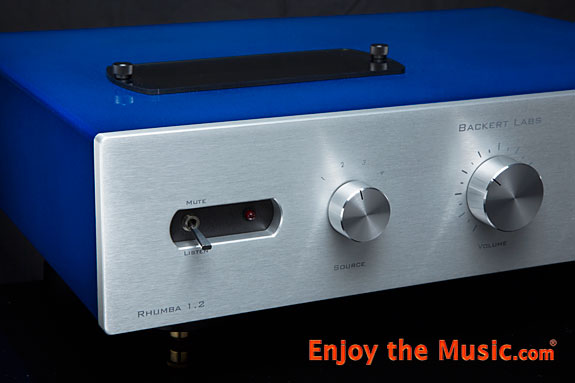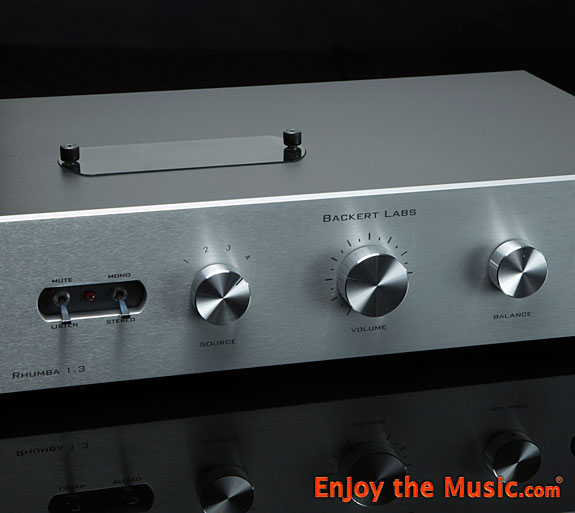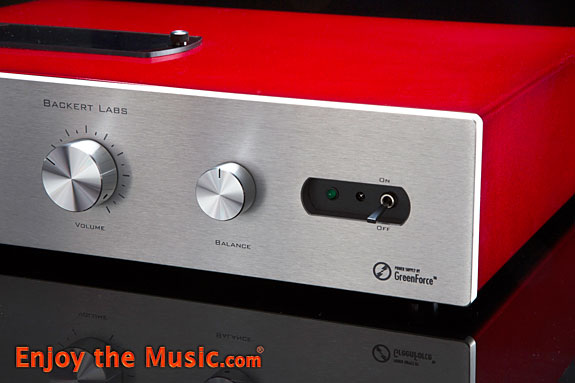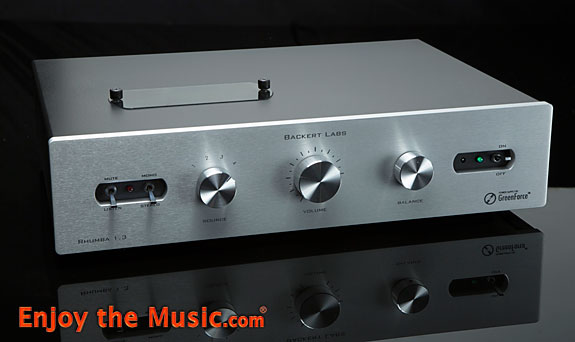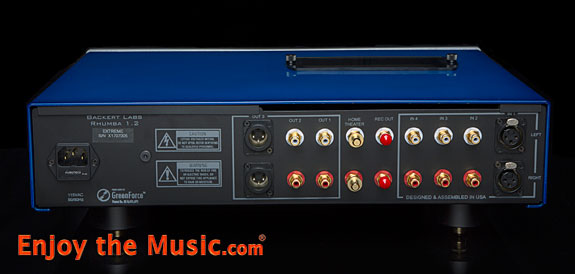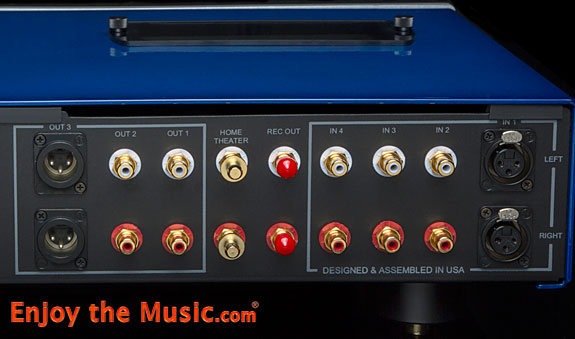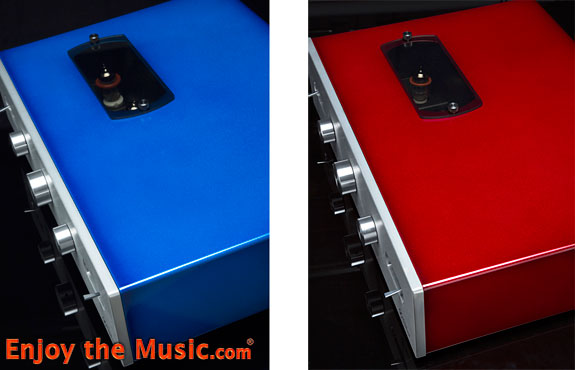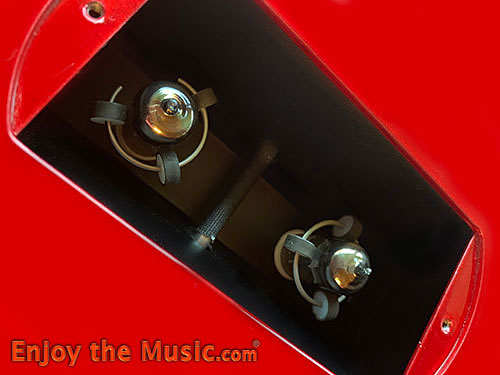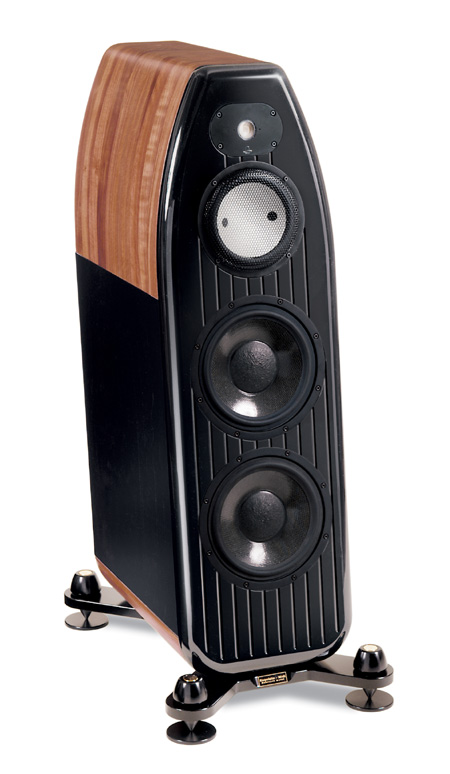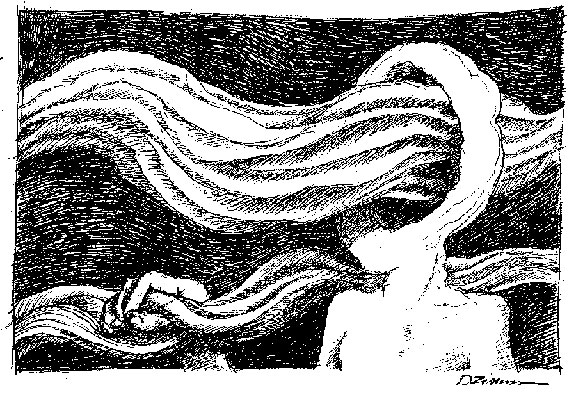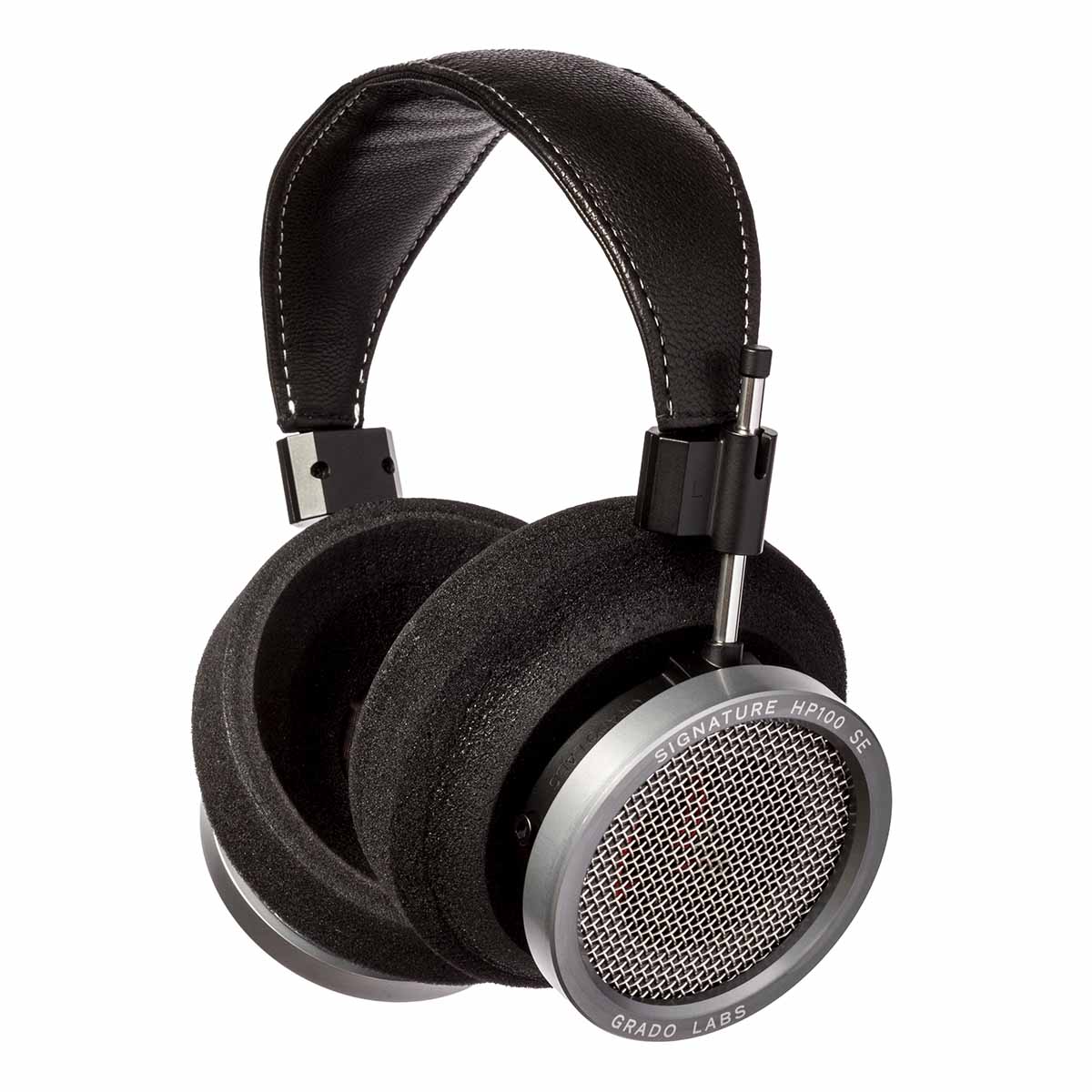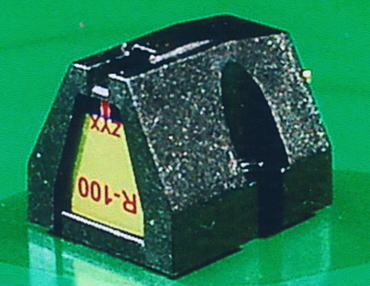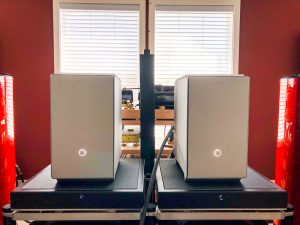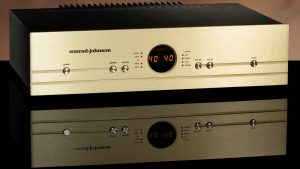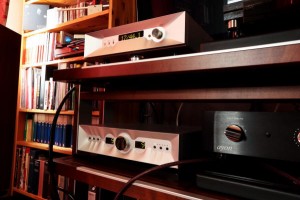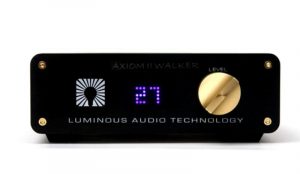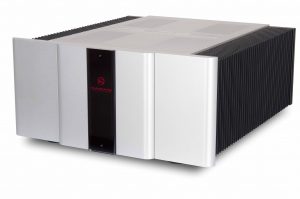With this article, Positive Feedback continues its content-sharing relationship with Enjoy the Music. Dean Cacioppo shares his thoughts about the Backert Labs Rhumba Extreme 1.3 Preamplifier. Read, and learn....
Dr. David W. Robinson, Editor-in-Chief
In my humble opinion, the two most under appreciated aspects of high-end audio are room acoustics / speaker placement and the preamplifier. These are the unsung heroes of the best sounding audio systems in the world. Speakers are generally front and center—kind of like a quarterback for a great football team. The power amplifier and the speakers complete the final circuit in audio reproduction, so the matching of the power amp and the speaker is crucial.
The audio source gets a tremendous amount of attention too. People get very excited and want to show off their new streaming system or turntable.
I have always thought that the preamp was the heart and soul of a great sounding system. You may switch speakers, which may cause you to look at a different power amp. You may upgrade your vinyl rig, purchase a new DAC, or add a high-def streaming system, but usually, the preamp stays constant. My point here is that, in many cases people give credence for the overall sound of their system to the source, speaker, and power amp—the preamp can many times get overlooked.
The Status Quo For Preamps
Many of the two-channel preamps on the market were built to match up with a particular power amplifier that the company had designed and was pushing, not truly as a stand-alone product. They want to ensure that the ever-crucial preamp output impedance is matched perfectly for the amplifier in question, and shows the amplifier in the best light. They are usually voiced to work in concert. This may have something to do with why some extremely high-end integrated amps have such magic as the Audio Note Ongaku.
There are certain companies that have consistently built impressive preamplifiers that stand on their own. One of those companies is Audio Research Corporation (ARC), going back to the SP3 in 1973, all the way to the current Reference 6. Some companies have struck gold with outstanding preamplifiers, such as the CAT SL1 and the Audible Illusions Modulus 3A on the more affordable side. That is why when I heard that a relatively new company, Backert Labs, was building nothing but preamplifiers, I got excited. I thought to myself, "these guys must see things the way I do" to build an entire company on just preamps.
Backert Labs - The Preamp Specialists
Backert Labs was started by Bob Backert, who has made a name for himself modifying tube amps and preamps for audiophiles for years, together with his son Gary Backert and one of his faithful modding customers, Andy Tebbe. Design duty is handled by Mr. Backert, while Gary oversees product construction. Andy serves as Backert Labs' president and assists with the voicing of their products.
As I already mentioned, Backert Labs only makes preamplifiers. They have two main preamp models: the Rhythm and the Rhumba. As of the time of this writing, the Rhythm 1.3 is their flagship model at $9995, and the Rhumba 1.3 is $4000. The Rhumba can be purchased with a stunning red or blue body for an additional $200.
Their new model (which is the subject of this review) is the Rhumba Extreme, priced at $6500. The Extreme version of the Rhumba claims to have much of the sonic attributes of their flagship, but in the Rhumba chassis.
There are some other differences between the Rhumba Extreme and the Rhythm such as:
- Dual mono regulator, as opposed to the Rhythm's fully dual-mono power supply.
- Different brands of output caps.
- The Rhythm uses Teflon power supply caps, while the Rhumba Extreme's are polypropylene "Jantzen Silver" from Denmark.
- The Rhythm has two fully balanced XLR inputs, while the Rhumba Extreme has one. (Both have three RCA inputs, two RCA outputs, and one XLR output.)
In speaking with Andy, he stated that the Rhumba Extreme was developed to deliver 90% of the sound of their flagship at a substantially lower price point—essentially their Rhythm preamp for several thousand dollars less.
Should Preamps Have A "Sound?"
We all state that we want absolute transparency with any piece of high-end audio equipment. Truth is, the real magic of a music system comes when the sonic attributes of all pieces of equipment work in synergy.
The function of the preamplifier is to:
- Let you choose the source
- Add an additional stage of amplification
- Provide attenuation
- Drive the power amplifier
Most audiophiles would state that the perfect preamplifier does all of the above and adds nothing to music. In reality, all preamplifiers will always affect the sound of your overall system, the key is to make sure that the sonic signature of your next preamp is something that adds to the enjoyment of the system as a whole. In the worst of scenarios, a preamp won't have the "muscle" to drive a particular amplifier. This type of mismatch (output impedance of the preamp to the input impedance of the power) is the most common way preamplifiers stand out, and it's not in a good way. It's worth noting that the Backert Labs Rhumba Extreme claims to have an exceedingly low output impedance of 75 Ohms, which will drive any amplifier on the planet. With that low of an output impedance, I was a little bit shocked by the lack of headphone jack.
The preamp should also be able to stand on its own as a great audio component, not just something that mates well with the current amplifier of choice.
The Rhumba Extreme Features And Specs
The Rhumba Extreme has much of what you would expect for a truly high end, two-channel preamplifier. It has an easy-to-use layout with a slightly larger volume flanked by the source and balance knobs. On the right side of the unit, you have a rocker switch for power, and the left has two rockers—one for a full mute and one for stereo/mono. Both toggles have LEDs to show the operation, and the volume has an LED so you can easily see how much you are cranked up in the dark. The faceplate is made of a solid piece of brushed aluminum and everything feels like a first-class piece of audio equipment.
The Extreme has a stereo set of fully balanced XLR, and three sets of RCA unbalanced inputs. As for outputs, you get fully balanced XLR and two stereo sets of unbalanced RCA, plus a set of tape-outs. The unit offers a home theater bypass feature, which can pass the front two channels of a video processor through the preamp. Note that the unit has to be off for that function to work.
The Extreme comes with adjustable spikes for leveling and noise isolation. The top of the unit has a pill-shaped piece of Plexiglas that is easily removed by thumbscrews to access the two 12AU7 / 6189 / ECC82 tubes. Once the Plexiglas is removed, all of the innards are covered, with the exception of the two tube sockets. Personally, I absolutely love the ability to easily and safely swap out the tubes. They even provide a pair of tube dampeners. This is really a tube roller's preamp.
The Rhumba Extreme also comes with a remote that only controls volume. This remote is hefty, as in really hefty. Does anyone remember the old Wadia remotes that could double as a weapon? The remote for the Rhumba Extreme is not too far behind. Seems like a little overkill for a remote that only has two small buttons, but cool nonetheless.
Unpacking The Rhumba Extreme
The unit that Backert Labs sent to me had the red body color option. Upon unpacking the Rhumba Extreme, the first thing that was abundantly obvious was the red top and sides, and the contrast to the front plate. This thing is pretty...as far as a piece of audio equipment can really be beautiful; the Rhumba is reminiscent of an immaculate custom paint job on an American muscle car. I would think that the blue option looks just as good.
First Notes Of The Backert Labs Preamp
In the current main system, I was going to be unplugging an Audio Research LS 2 to make room for the Rhumba. She was going to be driving an Audio Research Classic 60. Upon connecting everything, and giving the unit a measly five minutes to warm up, I already had Eric Clapton Unplugged on the turntable—so I cued it up. The dynamics were immediately noticeably improved. The LS 2 is no slouch when it comes to being punchy, but the Rhumba really made it sound a little flat. When I reference dynamics, I'm not directly referring to soft to loud, but the inner dynamics of the music. It is the ability for instruments and sounds to have their own dynamic qualities taking place during the macro-dynamics of the music. The ability for the Rhumba to have a finesse of the micro-dynamics, while having a very powerful and vigorous sound, was the most noticeable (and a little bit shocking) attribute out of the box.
The first impressions of the tonal balance of Rhumba Extreme are best described as harmonically accurate and quite neutral. Although the Rhumba did not sound overly tubey or bloated in any way, the harmonics around the music seemed to dissipate into nothingness with grace.
Lastly, I noticed that the overall gain on the Rhumba Extreme was a little lower than some other preamps. This in no way means that it can't drive amps properly or have great dynamics, it simply means that the potentiometer ends up being turned up higher to get the same volume. Somewhere in years of dealing with high end audio equipment, I seem to remember that "pots" perform better and are more linear as they get turned up higher. This leaves me to wonder if the lower gain with the incredibly low output impedance was a strategic design effort.
Change Of Systems
Although the ARC LS2 that the Rhumba was replacing is considered to be a pretty damn good preamp, I wanted to do some A/B comparisons against some more modern equipment that may be considered competition for a high-fi enthusiast looking for a great preamp. To do this, I packed up the Rhumba Extreme and went to visit my old friends at New Orleans' only real hi-fi shop, Wilson Audio. They were nice enough to give me full access to a listening room, and access to equipment to compare to the Rhumba.
We set up some Dynaudio Special Forty's, powered by an Audio Research VT80. The preamp that we used for a baseline was the Rouge Audio RP-5, which is the baby brother to the critically acclaimed RP-7. After a few minutes of listening, we swapped out the Rouge for the Rhumba Extreme.
The Rhumba was decidedly better in just about every area. More dynamic with better attack, substantially better bottom end, a more defined image, and much more air. The image with the Rhumba was more focused and tangible. To be fair, the Rhumba costs quite a bit more than the RP-5, so I thought we should step it up a little bit. In addition, the Rogue Audio doesn't have balanced outs—so the signal was quite a bit hotter with the Backert Labs Rhumba Extreme.
We decided to plug in the ARC LS17 SE preamplifier, as it is a wonderful sounding preamp by a company that strives to build some of the best sounding preamps you will find. Although a couple of years old, the LS17 SE hit the market as a scaled-down Ref 3, and punches way outside of its price range. The LS17 SE also has balanced outs for a more direct head to head comparison.
New Brand Versus Solidified Veteran
This was really putting the Rhumba Extreme to the test, as we are placing a first-generation, newly designed preamp against a company that has established themselves with over 50 years of building some of the finest preamplifiers ever made. With little delay, and a lot of excitement, we put some standard demo music on including multiple Lyle Lovett CDs as well as Dire Straits' On Every Street, Jennifer Warnes' Famous Blue Raincoat, and Janis Ian's Breaking Silence.
The difference in sound between the two preamps was not subtle. This is where things get to be a matter of subjectivity. The ARC sounded slightly more focused, but seemed to have a "halo" around the image. The best way I can explain it is the audible equivalent of having your center image inside of a water bubble, with a slight glow around the edges. This specific tonal attribute, although very pleasing to the ear and sharp, doesn't seem quite as realistic as the more airy, Rhumba Extreme, where the image seemed to float in space.
The Rhumba's harmonic balance was excellent. The slightest differences in timbre were drawn out and put on a platter for your musical enjoyment. The Rhumba was able to deliver a deep, multi-level image, with a warm but airy tonal balance. Not ever sounding tubey, but really delivering on harmonic decay and simply really pleasant to listen to.
One of the few definitive places where the Backert Labs stood out over the ARC was the accuracy of the bottom end. Where the LS17 SE sounded a little more rounded and tube-like, the Rhumba Extreme was solid, almost solid-state like. Transients were fast and energetic. The floor toms from Jennifer Warne's version of "Bird on a Wire" really stood out as powerful and authoritative without any bloat.
Roll Your Own—The Beauty Of Tube Rolling
Back at the humble abode, I swapped out the Vandersteen 3A's for the Spendor FL-10s to dig in even deeper to the already impressive Backert Labs Rhumba Extreme. The unit continued to get better in all areas as it broke in—to the point where I started making mental notes on how I could convince myself I needed a new preamp.
I had already kept the demo unit longer than I should have, and was feeling the pressure to get it boxed up and sent back. A day or so before I was planning on packing it up, Andy Tebbe with Backert Labs reached out to ask if I had a chance to try any different tubes. Although I love the ability to change the tonal balance of tube equipment by experimenting with different tubes, I did not have any quality 6189s to tube roll with. Andy agreed to send me a couple of sets of tubes they'd had good results with.
I was super stoked, as I now had a good excuse to spend more time with the Extreme.
About a week later, I received some NOS Mazda 12AU7s in the mail. He also said that I had a matched pair of NOS Mullards on the way to me from a Canadian company called MullardTubes.com. Tube rollin' with the Backert Labs Rhumba is a breeze. All you do is power it down, unscrew the top thumbscrews, pull the old tubes out, and put the new tubes in. You don't need to take the unit apart or feel that you may break something to quickly put different tubes to the test. Easy peasy.
Upon putting in the Mazdas, the difference was stunning. I have already spoken quite a bit about the outstanding harmonic decay I have experienced with the Rhumba Extreme; with the Mazdas that improved even more. Really a striking improvement.
Because swapping tubes is so fast, you can easily make direct A/B comparisons, and really fine-tune your system. Swapping tubes is a relatively inexpensive and fun way to tweak out your system. You'll notice very big results, and the nifty little opening in the top of the Rhumba is just begging you to swap tubes. As for the NOS Mullards, I ran out of time. The good news is the Rhumba Extreme comes stock with a set of perfectly decent "new issue" Mullards distributed by New Sensor.
Final Words On Sound And Value
To provide value, audio equipment needs to be able to provide a level of listening enjoyment that would usually cost more than the current price tag. It needs to be flexible enough to be paired with a wide variety of products and well-built with quality components The Backert Labs Rhumba Extreme seems to hit all the notes. In wrapping up, I have to mention the fact that most people that have an obsession with music, do not have $6500 to spend on a preamplifier. Although surely not at the upper extremes of price for a world class preamplifier, the Backert Labs Rhumba Extreme is competing with the big boys.
As many audiophiles have pointed out, there is a level of diminishing returns when you start reaching for the ultimate in audio equipment. The price range of the Rhumba Extreme, I feel they have hit a "sweet spot" in the price range of high end preamps. They are priced on the low end of the high end while being a formidable opponent to any preamplifier at any price. As an added benefit, the extremely low output impedance lets the Rhumba be paired with amplifiers that other preamps my struggle to drive.
In my humble experience, the Rhumba Extreme is a serious contender if you are looking for a top notch preamplifier that has a neutral presentation, excels in macro and micro dynamics and gets the harmonics of delicate music right. They seem to get everything right, while not having to take out a second mortgage on your home. If you are looking to bring new life into your system by upgrading your preamp, you would be doing yourself a disservice if you don't have the Rhumba Extreme on your shortlist.
Specifications
- Type: Vacuum tube stereo preamplifier
- Frequency Response: 6Hz to 109kHz (+/-1dB)
- Inputs: Balanced XLR input plus three unbalanced RCA
- Outputs: Balanced XLR output and two unbalanced RCA
- Channel Separation: Better than 78dB
- S/N Ratio: 98 dB referenced to 2.5V output, 9dB/1V
- THD+Noise: 0.09%
- Gain: 7 dB
- Input Impedance: 56 kOhms
- Output Impedance: Below 80 Ohms
- Power Supply: Dual-mono, with V-Cap copper foil capacitors
- Premium silver capacitors for output duty from Jantzen
- Chassis Dimensions: 17" x 12" x 4" (WDH not including feet)
- Weight: 17 lbs.
Rhumba Extreme
Retail: $6500
Backert Labs
501 Gibben Rd
Hockessin, DE 19707
302.723.7549
Check out Enjoy the Music for more articles and reviews




